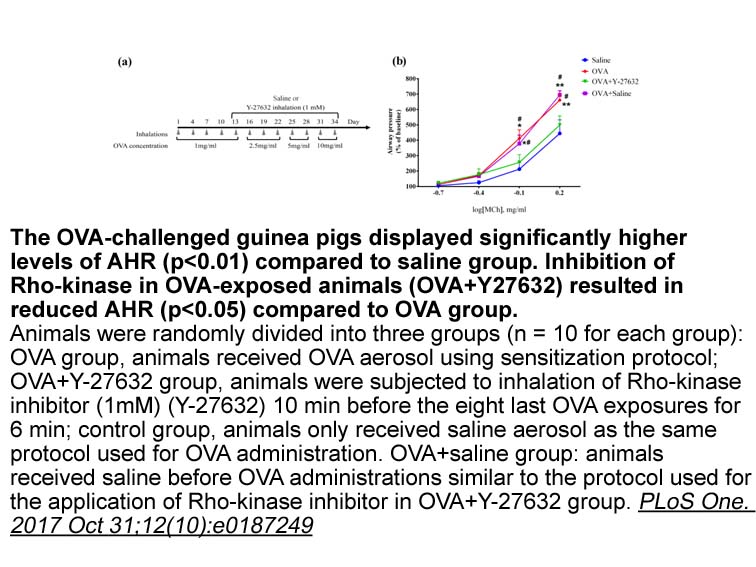Archives
br Conclusion Interactions between neurons and
Conclusion
Interactions between neurons and astrocytes depend on the spatial configuration of their contacts. Therefore, changes of astrocyte morphology may impact various physiological mechanisms ranging from glutamate uptake and potassium homeostasis to modulation of synaptic transmission and plasticity. Our current knowledge about the signalling cascades that control astrocyte morphology is largely derived from reduced preparations such as dissociated astrocyte cultures. In these, GTPases  of the Rho family and especially RhoA/ROCK represent powerful modulators of astrocyte structure. If and how neuronal network activity and other signalling events determine the activity of astrocyte Rho GTPases and thus astrocyte morphology in more intact preparations and in vivo is largely unexplored. Answering these questions represents a technical and conceptual challenge, but would also shed light on the mechanisms that control physiological and pathological astrocyte–neuron interaction within an intact network.
of the Rho family and especially RhoA/ROCK represent powerful modulators of astrocyte structure. If and how neuronal network activity and other signalling events determine the activity of astrocyte Rho GTPases and thus astrocyte morphology in more intact preparations and in vivo is largely unexplored. Answering these questions represents a technical and conceptual challenge, but would also shed light on the mechanisms that control physiological and pathological astrocyte–neuron interaction within an intact network.
Introduction
Regulation of the Rho GTPases is achieved by Rho NG,NG-dimethyl-L-Arginine hydrochloride nucleotide exchange factors (RhoGEFs) and GTPase-activating proteins (RhoGAPs). Numerous RhoGEFs catalyze the exchange of GDP for GTP on the Rho GTPases, which activates the proteins for subsequent regulation of downstream effectors. RhoGAPs enhance hydrolysis of the bound GTP on Rho, thus inactivating the GTPases. The dynamic balance between these two regulatory paradigms determines the effective action of specific Rho GTPases and their functional input into coordination of many cellular functions. Detailed properties and mechanisms of these proteins have been extensively reviewed elsewhere (Bos et al., 2007, Cherfils and Zeghouf, 2013, Etienne-Manneville and Hall, 2002, Rossman et al., 2005, Schaefer et al., 2014).
p190RhoGEF, also known as RGNEF (mouse) and designated as ARHGEF28, is an ubiquitously expressed regulator of RhoA (Gebbink et al., 1997). This protein contains the classic tandem DHPH domain motif common to the Dbl (diffuse B-cell lymphoma) family of RhoGEFs, as well as a leucine-rich domain, a zinc-finger region, and a coiled-coil motif (van Horck et al., 2001). The DH (Dbl homology) domains of RhoGEFs catalyze nucleotide exchange on the GTPases, while the PH (pleckstrin homology) domains may facilitate this activity or help localization of the RhoGEFs to their appropriate intracellular locations. p190RhoGEF specifically activates Rho isoforms (RhoA, RhoB, and RhoC), but not Rac1 or Cdc42 (Jaiswal et al., 2011, van Horck et al., 2001). Numerous binding partners for this RhoGEF have been identified including: a direct association of the C-terminal region of focal adhesion kinase (Zhai et al., 2003) and 14-3-3 proteins (Zhai et al., 2001) with sites in the coiled-coil region of p190RhoGEF, and an interaction of the scaffold protein, JIP-1, with a site C-terminal to the coiled-coil region (Meyer et al., 1999). The C-terminal region of p190RhoGEF can also associate with microtubules (van Horck et al., 2001) and the proximal untranslated region of mRNA for the neurofilament light subunit (Cañete-Soler et al., 2001). These binding interactions have suggested the importance of p190RhoGEF in focal adhesion formation, cancer cell motility, and neurodegeneration (Lim et al., 2008, Lin et al., 2005, Yu et al., 2011).
The well-defined domains of RhoGEFs play important roles in the regulation of these proteins. A novel role for the PH domain of RhoGEFs in the Lbc family was first indicated by the novel observation of the interaction between the PH domain of PDZRhoGEF (PRG) and its activated substrate, RhoA·GTPγS (Chen et al., 2010b); the inability of this binding interaction to affect basal stimulation of RhoA, in vitro, suggested an alternative mechanism for regulation. This was subsequently demonstrated when activated RhoA was shown to stimulate the activity of PRG by localizing the RhoGEF to the surface of membrane vesicles containing membrane bound substrate (Medina et al., 2013). Mutating the essential residues on the PH domain necessary for binding activated RhoA attenuated this stimulation. Mutation of this binding site also attenuated the ability of PRG to activate RhoA by overexpression in cells. These observations, both in vitro and in vivo, were expanded to the other 6 members of the Lbc family of RhoGEFs, including p190RhoGEF, thus definin g a general mechanism of positive feedback regulation for these RhoGEFs (Medina et al., 2013). Whether other members of the Rho subfamily of Ras GTPases can bind and regulate Lbc RhoGEFs is unknown.
g a general mechanism of positive feedback regulation for these RhoGEFs (Medina et al., 2013). Whether other members of the Rho subfamily of Ras GTPases can bind and regulate Lbc RhoGEFs is unknown.